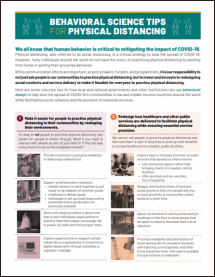Behavioral Science Tips for Physical Distancing
While communication efforts are important, policymakers, funders, and programmers have the responsibility to not just ask people in communities to practice physical distancing, but to invest and innovate in redesigning social contexts and service delivery to make it feasible for everyone to practice physical distancing.
This brief offers some concrete tips for how local and national governments and other institutions can use behavioral design to help slow the spread of COVID-19 in communities in low and middle-income countries around the world while facilitating social cohesion and the provision of essential services.
Last modified: May 3, 2020
Language: English

